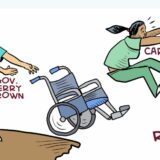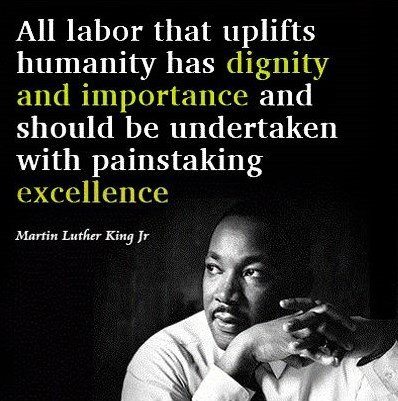

Last week, the U.K. publication The Guardian used an interesting anecdote to describe the key finding of an Oxfam report on global inequality: The world’s 85 richest people now own more wealth than the planet’s poorest 3.5 billion people. All of the world’s wealthiest individuals, Guardian writer Graeme Wearden noted, “could squeeze onto a single double-decker” bus.
The ironic image of the super-rich riding a humble public bus is an apt metaphor for the socioeconomic quandary facing America before President Obama makes his 2014 State of the Union address tonight. Underinvestment in job creation, training, education and public services like transportation put middle-class success out of reach for many Americans, while at the other end of the spectrum, wealth has been concentrated in very few hands.
President Obama’s speech ought to address the central problems of economic inequality and deficit of opportunities and services for many Americans.


Last month two of L.A.’s richest men decided they needed to defend their wealth in a Los Angeles Times opinion piece. The headline read: “It Isn’t a Sin to Be Rich.”
Of course it isn’t. No one has said it was a sin to be rich in a very long time. After all, rich is a state of being. It’s greed that makes the list of cardinal sins.
Naturally, social critics and political figures have spoken about the shrinking middle class. They’ve talked about the social instability caused by the exponential growth of wealth and the relatively shrinking resources of the working poor. Even film makers have produced documentaries describing a few people’s wealth growing so exorbitantly that it virtually pauperizes the rest of us. So apparently the two rich guys felt the sting and decided they needed to defend their class.


The national debate over the quality of public school education and its teachers shifts to a courtroom this morning as day one of Vergara v. California opens in Los Angeles County Superior Court.
Filed on behalf of nine student plaintiffs (including Beatriz and Elizabeth Vergara), the suit seeks to wipe out the core of state teacher employment rights by overturning five California statutes that it claims make it too difficult to dismiss ineffective teachers.
The lawsuit was originally filed in the spring of 2012 by Students Matter, a Bay Area nonprofit created by the wealthy Silicon Valley entrepreneur David Welch and financed partly by L.A. billionaire Eli Broad.
That’s when Students Matter revealed the names of an advisory committee that reads like a Who’s Who of privatized education interests. Heading the list is Students First,
» Read more about: Vergara Trial Targeting Teachers’ Rights Opens »


Andrea Vidales makes $9 an hour taking care of a blind Korean War veteran and an elderly couple in their Merced County homes. Under California’s In-Home Supportive Services (IHSS) program, she spends about 60 hours every week bathing her clients, preparing their meals, cleaning house, paying their bills, driving them to doctors and dealing with other aspects of their medical care. She was delighted, then, when the Obama administration, through the U.S. Department of Labor, announced new regulations last September requiring in-home caregivers to be paid overtime for working more than 40 hours a week.
Her good fortune didn’t last long. On January 9, Governor Jerry Brown unveiled his proposed $155-billion budget for 2014-2015 at a press conference in Sacramento. Under the governor’s budget, Vidales and hundreds of thousands of other home health care workers would be prohibited from working more than eight hours a day, or 40 hours a week.


Last week’s announcements about 2013 earnings by California’s largest public pension funds suggest the agencies may be making significant progress in shaking off the lingering after-effects of the 2008 stock market crash.
The California Public Employees’ Retirement System (CalPERS) said it rode a 25 percent run-up in stock prices to post a 16.2 percent gain for its 2013 portfolio — its best showing in a decade. For its part, the California State Teachers’ Retirement System (CalSTRS) reported an impressive 19.1 percent return on its 2013 investments, led by a 28 percent return on its stock holdings.
The announcements undoubtedly came as welcome news to the roughly 1.6 million California government workers and 860,000 public school teachers represented by the systems. Ever since the 2008 global financial meltdown, their pensions have been in the crosshairs of fiscal conservatives and anti-public pension activists who wish to see the employees’


Last year, as we remembered the life and legacy of Reverend Dr. Martin Luther King, Jr., we focused much of our attention on the 50th anniversary of the March on Washington for Jobs and Freedom. We reflected on the historical words that followed, “I have a dream” and reaffirmed our commitment to keeping the dream alive.
We measured our progress through victories such as the end of Jim Crow segregation, the passage of the Civil Rights and Voting Rights Acts, and the election of our first African American President. We also talked about where we need to devote our efforts for the dream to become a reality.
With that, one year later we are reminded of the inequalities that still exist and the call to action we must all answer:


“I’m not in despair, because I know that there is a moral order. I haven’t lost faith, because the arc of the moral universe is long, but it bends toward justice.”


We all know the political shorthand: “red” states vote conservative while “blue” states vote progressive. But these days the deep red hue of Idaho, Arizona and Texas isn’t just a reflection of their political leanings; it’s all the red flags voters are raising about private prisons in those states.
In 1997, Corrections Corporation of America (CCA) took over the Idaho Correctional Center. Predictably, the facility was soon plagued with rampant violence, understaffing, gang activity and contract fraud committed by CCA. One former inmate said the facility was so violent that it was commonly referred to as “gladiator school.” What’s more, in 2012 the Associated Press showed that taxpayers didn’t even get the savings they were promised.
This month, tired of the bad headlines, Idaho Governor Butch Otter – a strong proponent of outsourcing – announced that the state is taking back control of the privately run prison.
» Read more about: States Are Regretting Prisons for Profit »


I knew him. He ran the lathe next to mine.
Perfectionist, a madman, even on overtime
Saturday night. Hum of the crowd floating
from the ball park, shouts, slamming doors
from the bar down the street, he would lean
into the lathe and make a little song
with the honing cloth, rubbing the edges,
smiling like a man asleep, dreaming.
A short guy, but fearless. At Margie’s
he would take no lip, put the mechanic big
as a Buick through a stack of crates out back
and walked away with a broken thumb
but never said a word. Marge was a loud,
dirty girl with booze breath and bad manners.
He loved her. One night late I saw them in
the kitchen dancing something like a rhumba
to the radio, dishtowels wrapped around
their heads like swamis.


There was a time when we listened to science, leaned forward when its experts spoke about smoking, clean air and water, or the need for something called a seatbelt. But that was long ago, before corporate interests convinced us that the best policy for just about any social crisis was to do nothing. Today research surveys that statistically demonstrate the benefits of raising the minimum wage have about the same chance of being heard above the denial din as climate change papers.
Nevertheless, the authors of Effects of a Fifteen Dollar an Hour Minimum Wage in the City of Los Angeles, a new study conducted by the Economic Roundtable and funded by the Los Angeles County Federation of Labor, hope to open some very closed minds about these economic benefits. Tuesday the two groups released the study at a media event held on a corner of Lafayette Park.
» Read more about: 7.6 Billion Reasons to Raise L.A.’s Minimum Wage »